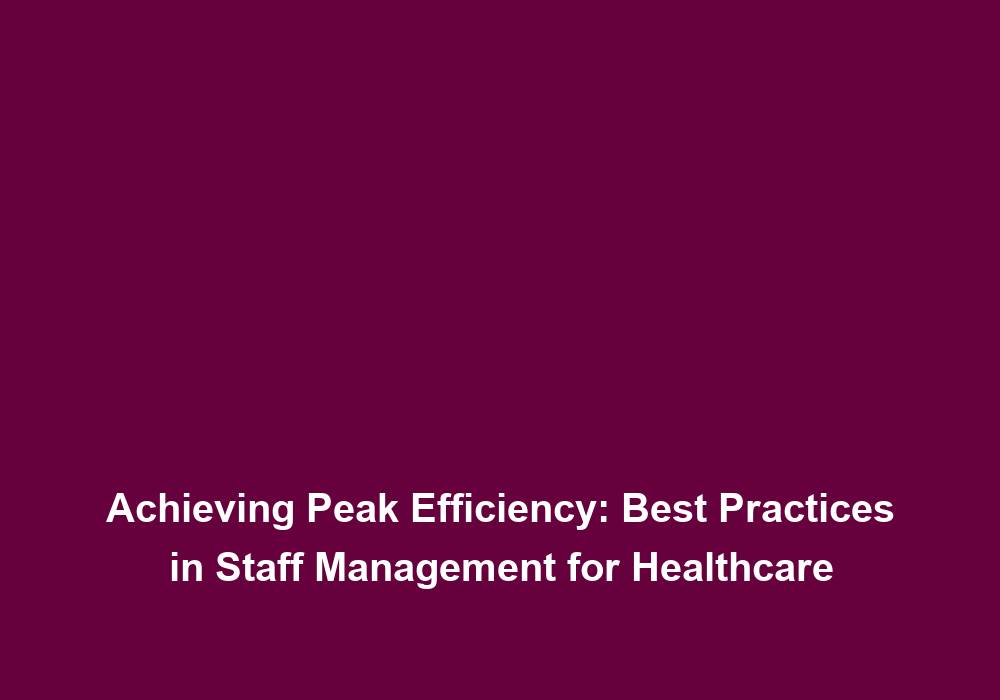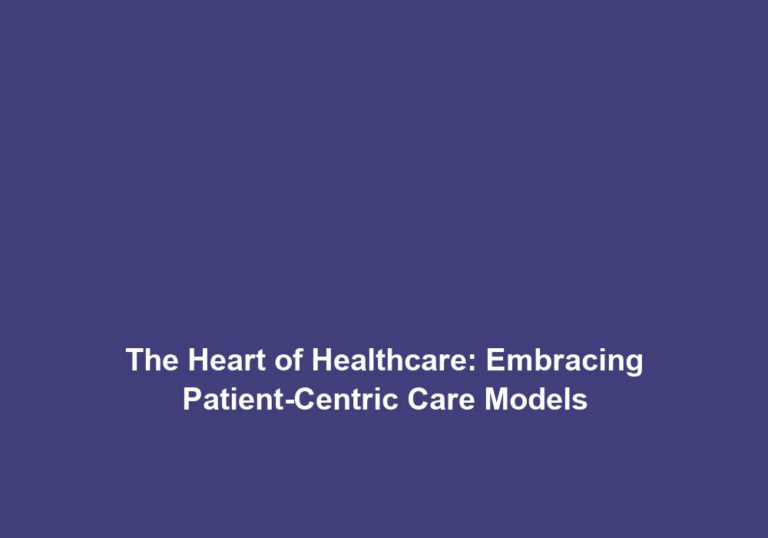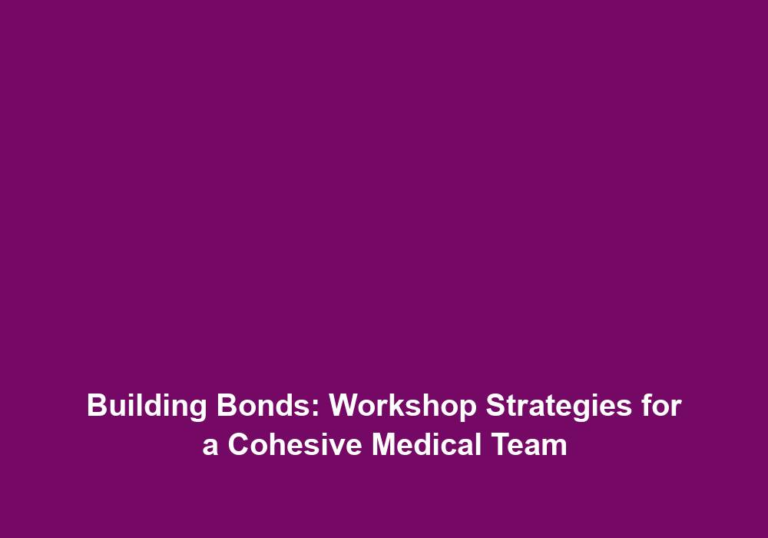Achieving Peak Efficiency: Best Practices in Staff Management for Healthcare
In the fast-paced and demanding healthcare industry, effective staff management is crucial for providing high-quality patient care and maintaining organizational success. By optimizing productivity, streamlining workflows, and ensuring a harmonious work environment, healthcare facilities can achieve peak efficiency. This article delves into the best practices in staff management for healthcare, providing valuable insights and practical tips.
Importance of Staff Management in Healthcare
Staff management plays a pivotal role in healthcare organizations as it directly impacts patient outcomes, staff satisfaction, and overall operational efficiency. Let’s explore the importance of staff management in more detail:
-
Ensure optimal patient care: Efficient staff management ensures that the right staff members with the necessary skills and expertise are available to provide timely and high-quality care to patients. This includes assessing patient volume, acuity levels, and service demands to determine optimal staffing levels across various departments. By having the right staff in place, healthcare organizations can meet patient needs effectively.
-
Improve patient satisfaction: Managing staff effectively has a direct impact on patient satisfaction. By minimizing wait times, enhancing communication, and fostering positive patient experiences, healthcare organizations can improve patient satisfaction scores. This involves creating efficient staff schedules that align with patient demand and workload. Utilizing scheduling software or platforms can streamline the process, enabling managers to efficiently assign shifts, manage time-off requests, and ensure adequate staffing coverage.
-
Enhance staff productivity: Implementing best practices in staff management optimizes staff performance, reduces burnout, and boosts productivity levels, resulting in improved healthcare delivery. Investing in robust onboarding and training programs equips new hires with the knowledge, skills, and resources required to perform their roles effectively. By providing comprehensive orientation and ongoing training, healthcare organizations ensure that staff members are up-to-date with the latest industry standards, protocols, and technologies.
-
Reduce costs: Efficient staff management involves aligning staffing levels with patient demand, eliminating unnecessary overtime, and optimizing resource utilization, thereby reducing operational costs. By developing a comprehensive workforce plan, healthcare organizations can identify current and future staffing needs. This involves analyzing patient volume, acuity levels, and service demands to determine optimal staffing levels across various departments.
Key Best Practices in Staff Management for Healthcare
Implementing the following best practices can significantly enhance staff management and drive peak efficiency in healthcare organizations:
1. Workforce Planning and Recruitment
Developing a comprehensive workforce plan is essential for healthcare organizations to identify current and future staffing needs. This involves analyzing patient volume, acuity levels, and service demands to determine optimal staffing levels across various departments. By forecasting staffing requirements, healthcare organizations can proactively address any potential gaps and ensure seamless operations. Additionally, recruiting and selecting the right candidates with the necessary skills, experience, and cultural fit is crucial for achieving staffing excellence. Implementing effective recruitment strategies, such as targeted job postings, thorough interviewing processes, and reference checks, can help healthcare organizations attract and hire top talent.
2. Effective Onboarding and Training Programs
Investing in robust onboarding and training programs is vital for equipping new hires with the knowledge, skills, and resources required to perform their roles effectively. By providing comprehensive orientation and ongoing training, healthcare organizations can ensure that staff members are up-to-date with the latest industry standards, protocols, and technologies. This includes incorporating e-learning modules, hands-on training sessions, and mentorship programs to facilitate continuous learning and development. Regularly evaluating the effectiveness of onboarding and training programs allows healthcare organizations to make necessary improvements and address any gaps in knowledge or skill sets.
3. Staff Scheduling and Shift Management
Creating efficient staff schedules that align with patient demand and workload is essential for maintaining optimal staffing levels and avoiding excessive overtime. Utilizing scheduling software or platforms can streamline the process, enabling managers to efficiently assign shifts, manage time-off requests, and ensure adequate staffing coverage. It is important to consider factors such as staff availability, skill mix, and workload distribution when creating schedules. By involving staff in the scheduling process and allowing for flexibility, healthcare organizations can improve staff satisfaction and engagement. Regularly monitoring and adjusting schedules based on patient volumes and staff feedback helps ensure that the right staff members are in the right place at the right time.
4. Performance Evaluation and Feedback
Regular performance evaluations and constructive feedback are crucial for motivating staff, identifying areas for improvement, and fostering professional growth. Implementing a fair and transparent performance management system helps healthcare organizations recognize and reward exceptional employees while addressing any performance concerns promptly. This includes setting clear performance expectations, conducting regular check-ins, and providing timely feedback. Performance evaluations should consider both quantitative and qualitative measures, such as productivity metrics, patient feedback, and peer evaluations. By providing ongoing support and guidance, healthcare organizations can create a culture of continuous improvement and empower staff to reach their full potential.
5. Effective Communication and Collaboration
Open and effective communication channels are vital for fostering collaboration, enhancing teamwork, and ensuring smooth workflow within healthcare organizations. Implementing regular team meetings, utilizing communication tools, and encouraging a culture of open dialogue can improve staff engagement, morale, and overall productivity. Effective communication involves active listening, clear and concise messaging, and timely information sharing. Providing opportunities for staff to provide input, share ideas, and participate in decision-making processes promotes a sense of ownership and fosters a collaborative work environment. Additionally, establishing interdisciplinary communication channels facilitates coordinated care and enhances patient outcomes.
6. Staff Engagement and Recognition
Recognizing and appreciating staff contributions is key to maintaining high morale and promoting staff engagement. Implementing employee recognition programs, celebrating achievements, and providing opportunities for career advancement demonstrates the organization’s commitment to its staff, leading to increased job satisfaction and loyalty. This includes acknowledging and rewarding staff for their hard work, dedication, and outstanding performance. Implementing regular feedback sessions, conducting employee surveys, and involving staff in decision-making processes contribute to a positive work culture. Healthcare organizations can also offer professional development opportunities, such as leadership training and mentorship programs, to support staff growth and career progression.
7. Continuous Professional Development
Investing in staff’s continuous professional development is crucial for promoting growth, improving skills, and keeping up with advancements in the healthcare industry. Offering opportunities for further education, training, and professional certifications not only benefits individual staff members but also enhances the overall competency and quality of care provided. Healthcare organizations can provide access to relevant conferences, workshops, online courses, and industry publications. Encouraging staff to pursue ongoing learning and supporting their career aspirations creates a culture of continuous improvement and innovation.
8. Employee Wellness and Work-Life Balance
Prioritizing employee wellness and work-life balance is essential for preventing burnout, improving staff retention, and maintaining a positive work environment. Implementing wellness initiatives, providing access to counseling services, and promoting work-life balance initiatives can significantly contribute to staff satisfaction and well-being. This includes offering flexible work arrangements, encouraging regular breaks, and promoting self-care practices. Healthcare organizations can also facilitate team-building activities, stress management programs, and resilience training to support staff well-being. By fostering a healthy work-life balance, healthcare organizations can promote a positive culture and ensure staff longevity.
9. Utilizing Technology and Automation
Leveraging technology solutions, such as electronic health records (EHRs), scheduling software, and task management systems, can streamline administrative tasks, improve efficiency, and enhance communication within healthcare organizations. Embracing automation reduces the administrative burden on staff, enabling them to focus more on patient care. EHRs enable seamless documentation, information sharing, and care coordination. Scheduling software simplifies the process of creating and managing staff schedules, ensuring optimal coverage and reducing scheduling conflicts. Task management systems facilitate task assignment, tracking, and collaboration, promoting productivity and accountability. Healthcare organizations should regularly assess and invest in technology solutions that align with their specific needs and goals.
10. Continuous Quality Improvement
Adopting a culture of continuous quality improvement is vital for ensuring ongoing staff management excellence. Regularly evaluating and refining staff management practices based on feedback, data analysis, and industry best practices can drive continuous improvement and help healthcare organizations stay ahead of the curve. This includes conducting regular audits, seeking staff input, and benchmarking against industry standards. By identifying areas for improvement and implementing evidence-based practices, healthcare organizations can enhance staff management processes and ultimately deliver better patient care.
Conclusion
Effective staff management is a cornerstone of successful healthcare organizations. By implementing best practices in workforce planning, recruitment, training, scheduling, performance management, communication, and technology utilization, healthcare facilities can achieve peak efficiency, deliver exceptional patient care, and foster a positive work environment for their staff. Embracing continuous improvement, investing in staff development, and leveraging technology further contribute to optimizing staff management and achieving organizational success in the dynamic healthcare industry.







